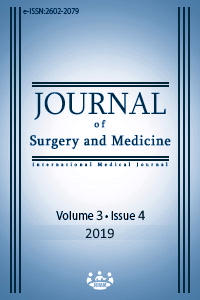Effect of neuropathy on pupillary response measured with infrared static pupillography in type 2 diabetes mellitus patients
Keywords:
Diabetes mellitus, Pupillography, Polyneuropathy, Diabetic complicationsAbstract
Aim: Diabetic autonomic neuropathy is manifested by pupillary dysfunction in the eye; so pupillary assessment can be vital for early detection. We aim to determine the relationship between diabetic polyneuropathy and pupil response for evaluating the presence of neuropathy via static pupillometer that is a non-invasive and quantitative method. This method could be used as an indicator for early diagnosis of neuropathy in diabetic patients.
Methods: This case-control study was planned on 420 patients. All participants have been diagnosed with Type 2 Diabetes Mellitus and were referred to Neurology Department. The first group includes 60 patients who have type 2 diabetes mellitus with distal symmetric polyneuropathy (DPN). Second group includes 212 diabetic patients who don't have polyneuropathy. Besides, age-sex matched 208 non-diabetic controls were included in the study. Mesopic, scotopic and photopic pupil measurements were recorded via infrared static pupillography.
Results: The photopic pupil diameter was 3.72 (0.86) mm, 3.64 (0.78) mm, 3.74 (0.78) mm and mesopic pupil diameter were 4.06 (0.76) mm, 4.22 (0.80), 4.39 (0.83) mm and scotopic pupil diameter was 4.58 (0.76) mm, 4.56 (0.84) mm, 4.77 (0.85) mm respectively in DPN group, non-neuropathic diabetic group, and control group. There was no statistically significant difference in groups (p>0.05) except for mesopic and scotopic pupil diameters between control and non-neuropathic diabetic group (p=0.03 and p=0.01, respectively).
Conclusion: Pupillographic methods are not as reliable as diabetic autonomic neuropathy in the early diagnosis of DPN.
Downloads
References
Guariguata L, Guariguata L, Whiting DR, Hambleton I, Beagley J, Linnenkamp U, Shaw JE. Global estimates of diabetes prevalence for 2013 and projections for 2035. Diabetes Res Clin Pract. 2014;103.2:137-49.
Katz B, Simmons I. Pupillary changes of diabetic eye. Ophthalmol Clin North Am. 1992;5:379-88.
Nakayama M, Nakamura J, Hamada Y, Chaya S, Mizubayashi R. Aldose Reductase Inhibition Ameliorates Pupillary Light Reflex and F-Wave Latency in Patients With Mild Diabetic Neuropathy. Diabetes Care 2001;24:1093-8.
Mc Nally PG, Lawrence IG, Panerai RB, Weston PJ, Thurston H. Sudden death in type-1 diabetes. Diab Obes Metabol. 1999;1:151-8.
Ko ML, Chen YY, Ouyang Y, Huang TW, Tsuen BS, Jeng WD, et al. Design and analysis of wearable pupillometer for autonomic neuropathy of diabetic patients. Appl Opt. 2014 Oct 10;53(29):H27-34. doi: 10.1364/AO.53.000H27.
Smith SE, Smith SA Pupillary signs in diabetic autonomic neuropathy Br Med J. 1978; 30;2(6142):924-7.
Young MJ, Boulton AJM, MacLeod AF, Williams DRR, Sonksen PH. A multicentre study of the prevalence of diabetic peripheral neuropathy in the United Kingdom hospital clinic population. Diabetologia 1993;36(2):150-4.
Tentolouris N, Pagoni S, Tzonou A, Katsilambros N. Peripheral neuropathy does not invariably coexist with autonomic neuropathy in diabetes mellitus. Eur J Intern Med. 2001;12:20–27.
Pozzessere G, Rossi P, Gabriele A, Cipriani R, Morocutti A, Di Mario U, et al. Early detection of small-fiber neuropathy in diabetes: a laser-induced pain somatosensory-evoked potentials and pupillometric study. Diabetes Care. 2002 Dec;25(12):2355-8.
Toyry JP, Partanen JV, Niskanen LK , Lansimies EA, Uusitupa MI Divergent development of autonomic and peripheral somatic neuropathies in NIDDM. Diabetologia 1997;40:953–8.
Winkler AS, Ejskjaer N, Edmonds M, Watkins PJ. Dissociated sensory loss in diabetic autonomic neuropathy. Diabet Med. 2000 Jun;17(6):457-62.
Dütsch M, Marthol H, Michelson G, Neundörfer B, Hilz MJ. Pupillography refines the diagnosis of diabetic autonomic neuropathy. J Neurol Sci. 2004:222(1-2):75-81.
Dyck PJ, Giannini C. Pathologic alterations in the diabetic neuropathies of humans: a review. J Neuropathol Exp Neurol. 1996;55:1181–93
Davson H. Physiology of the eye. 1980;New York: Churchill Livingstone.
Heller PH, Perry F, Jewett DL, Levine JD. Autonomic components of the human pupillary light reflex. Invest Ophthalmol Visual Sci. 1990;31:156–62.
Merritt SL, Keegan AP, Mercer PW. Artifact management in pupillometry. Nurs Res. 1994;43:56–9.
Alexandridis E, Argyropoulos T, Krastel H. The latent period of the pupil light reflex in lesions of the optic nerve. Ophthalmologica. 1981;182:211–7.
Smith SA, Smith SE. Reduced pupillary light reflexes in diabetic autonomic neuropathy. Diabetologia. 1983;24:330–2.
Hayashi M, Ishikawa S. Pharmacology of pupillary responses in diabetics—a correlative study of the responses and grade of retinopathy. Jpn J Ophthalmol. 1979;23:65–72.
Smith S, Dewhirst R. A simple diagnostic test for pupillary abnormality in diabetic autonomic neuropathy. Diabet Med. 1986;3:38–41.
Smith SA, Smith SE. Pupil function: test and disorders. In: Bannister R, Mathias CJ, editors. Autonomic failure. A textbook of clinical disorders of the autonomic nervous system. Oxford: Oxford Univ. Press 1999;245–53.
Piha SJ, Halonen JP. Infrared pupillometry in the assessment of autonomic function. Diabetes Res Clin Pract. 1994 Nov;26(1):61-6.
Downloads
- 1015 1622
Published
Issue
Section
How to Cite
License
Copyright (c) 2019 Gözde Şahin, Esat Karademir, Onur Temizsoylu, Mehmet Vural, Cenap Güler
This work is licensed under a Creative Commons Attribution-NonCommercial-NoDerivatives 4.0 International License.
















